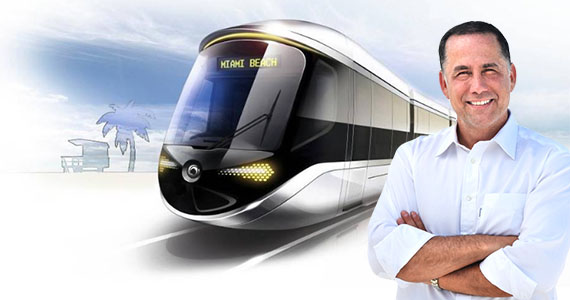Trending
Miami Beach puts $400M light rail system on hold

After mounting public opposition and fears about costs and compatibility with other mass transit systems, the Miami Beach City Commission on Wednesday said it was suspending plans for a 2-mile wireless streetcar system that would have cost at least $244 million.
Mayor Philip Levine first proposed the $400 million system that would have linked up with a mass transit system on the mainland, known as the “Bay Link” proposal. At Wednesday’s meeting, he said that before he would move forward on light rail, the city would seek a “binding” commitment from Miami-Dade County that any future light rail on Miami Beach would be connected to the mainland. Levine also said he supported a charter amendment that will have Miami Beach voters approve any system that would put tracks on Miami Beach streets.
City commissioners unanimously agreed to the proposals. Wednesday’s decision effectively delays an interim agreement the city had entered into with the French rail firm, Alstom, for a 35-year contract to build and maintain the system.
Several commissioners and a growing number of Miami Beach residents had grown increasingly critical of the proposed agreement, citing what they said was a lack of transparency in the bidding process and expressed concerns about exorbitant construction costs and fears about how a light rail system would only snarl traffic further on already congested Miami Beach.
Two other bidders for the contract also said the proposed Alstom system used propriety technology that would not be compatible with and would not be able to connect with any system run by the county on the mainland. Commissioner Kristen Rosen Gonzalez, who led opposition to the proposal, said the actual cost of the system would have been closer to $600 million.
On Wednesday, she presented Levine with a toy train she had bought saying “We wanted a train, so I bought you one at Ikea.”
Mayor Levine said the city will finish about $5 million in environmental studies it is conducting and that will allow the city to act once the county signals a willingness to link its mass transit system to a Miami Beach system. Once that analysis is complete, Miami Beach could be in the position to quickly link to one of six rail corridors known together as the SMART Place, which county officials unveiled earlier this year. The plan marks the first expansion of the Metrorail since the system opened in 1984.
“Now it’s up to the county,” Levine said. “We have done our part.”
Miami-Dade County transportation director Alice Bravo recently told the Miami Herald she supported extending the county’s automated Metromover system across the MacArthur Causeway to Miami Beach as a way of achieving a Bay Link between Miami Beach and the mainland.
Several commissioners who had originally backed the light rail system changed their minds once they began hearing from constituents – especially small businesses who have borne the brunt of nearly constant construction over the past several years, as the city has raised roads and installed an extensive pumping system on South Beach to deal with sea-level rise.
Commissioner Michael Grieco told TRD a light rail system just might make things worse on Miami Beach. “What keeps me up at night is the concept of laying tracks on streets, which could put every restaurant out of business and the final product could leave us worse off than before.”
In 2002, voters across Miami-Dade approved a half-percent sales tax with all revenues dedicated to improving mass transit. Critics say nearly all of the estimated $1.5 billion in revenue so far generated from the tax have gone to maintenance of the current Metrorail system, road construction, bus service and personnel costs.
For his part, Levine said he’s not giving up on the idea of light rail, citing a survey he privately contracted from McLaughlin & Associates. The survey showed that 71 percent of 300 likely voters on Miami Beach expressed support for a light rail system that would link Miami Beach with the city of Miami, and that 56 percent “strongly support” any such plan.
“The people of Miami Beach are clear, they want something done,” he said.




